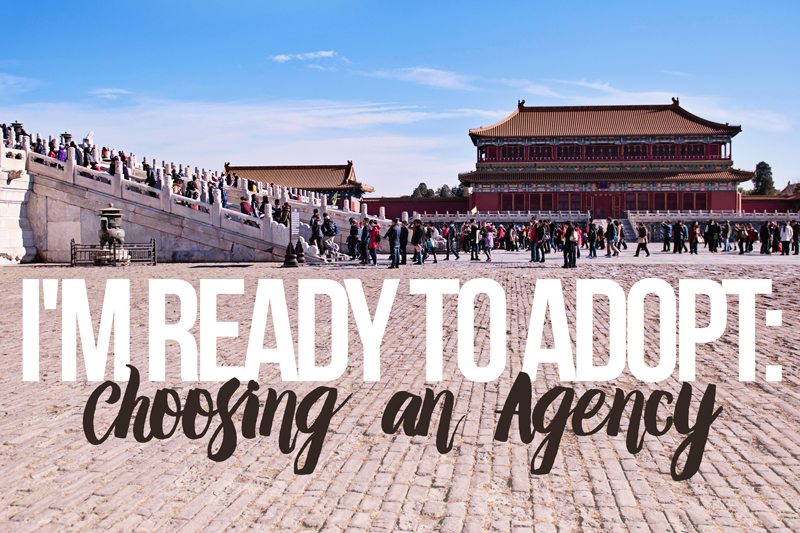Today we’re back with our I’m Ready To Adopt series with the third in a mini-series by Kelly – who blogs at Mine In China – on How To Choose An Agency. You can read the first two posts here and here.
Understanding LID and Partnership Files
In this post, we are going to focus on another file designation used by China, known as a LID file. To adopt a child from China, parents must first compile a dossier of documents required by China to prove that they are qualified to adopt. The dossier is sent to China where it is given a Log In Date (LID) when it is logged into the Chinese computer system.
Children who are designated LID are typically young children with minor needs who are reserved for those who already have a dossier logged into China’s system.
Q: What is the point in making some kids wait for families to have a Log In Date? Don’t they want these kids to find families?!
A. Most of the people who adopt from China will want to adopt a child who is very young and with minor needs. The majority want to adopt a girl specifically. At a certain point, China realized that the young children with minor needs were not going to have any trouble finding homes. In fact, most agencies have a waiting list of parents who are waiting to adopt them. People would “lock” these files before their dossier was ready, hit a snag with their homestudy or immigration approval and the child was still sitting around in the orphanage, getting older. By reserving these files for people who already have a dossier logged in, it moves the children through the system faster, getting them out of orphanages and into homes.
Q: What types of files are LID only? What exactly does “young with minor needs mean?”
A: China decides whether a file will be LID only or not. Usually it is children under the age of 3 with minor needs. But because people overwhelmingly prefer to adopt girls, they will accept a girl who is older and with more involved needs rather than adopt a boy. As a result, girls are often labeled LID only through age 5 – 7, or younger girls with more significant medical needs. Fewer boys are given a LID designation. However, there are no established guidelines for this and it sometimes seems pretty random which files get the LID only designation – I once saw a 6 year old boy with four different special needs listed as LID only.
If you know that you would like to adopt a young child with minor needs, and especially if you want this child to be a girl, LID only is probably the route for you. You should find your agency first and I suggest one with multiple orphanage partnerships. More on partnerships in a minute.
Q: Can I find a LID child that I’m interested in adopting and then sign with that agency?
A: According to China’s guidelines, agencies are not supposed to post LID designated files on photolistings. As mentioned previously, most agencies do not have any trouble placing LID files, at least if they are girls, and most have a waiting list of families so all the children you see on photolistings should theoretically be designated as special focus.
Q: What if no one is interested in the file? Will it always be LID only?
A: Agencies have designated LID files for three weeks, and then they will return to the shared list. If no one has sent a letter of intent to adopt a child after a month on the shared list, the LID only file can be switched to special focus. This opens a wider pool of prospective adoptive families for the child, and hopefully will enable them to find a family.
LID designated files are increasingly being designated to agencies through partnerships. Partnership files include both LID only and special focus but they will be designated to a single agency for a specific amount of time. Under the partnership system, agencies cultivate a relationship with an orphanage. The orphanage receives needed resources such as material aid (formula, crib mattresses), medical or teaching consultation. In return, agencies will be the first to receive new files which are prepared from their partner orphanage. Agencies can take more time to match the children with the right family who is waiting and the family has more time to review a file than was available when all files were pulled from the shared list. Many agencies will travel to their partnership orphanage(s) and get more information on children, to interact with them and get video to add to their files. For older children or those with harder to place needs, the agency can advocate for them through newsletters or blog posts knowing with no concern that after they find a family the file will have disappeared off the shared list.
…..
Many people do not realize that files are not prepared for all of the children in an orphanage. In fact, only a small portion of the children will have files prepared. The orphanage must bear the cost of having files prepared and so usually only those children considered “adoptable” will have the chance at a family. Through the partnership system some agencies are encouraging orphanages to prepare the files of children who might not have been selected initially. During a visit, the agency representative might say “We really think we could place this child.” Often the agency will pay to have the file prepared, so there are some children who would never have been eligible for adoption if it weren’t for a partnership.
The shared list is a list of files for children which are available to any agency. It includes children who are designated both LID only and special focus, although the majority are special focus. All agencies have access to the shared list, but many will have access to additional files which are designated to their specific agency. Many of these are through a partnership agreement.
I think the partnership system, while not perfect, is an improvement. Previously, new files were added to the shared list once a month. It used to be that on that day agency representatives would stay up late to rush to match families with files the instant they appeared, competing against each other for the most desired files. Families had two days to make a decision, which wasn’t always enough time to get a thorough review from a doctor. Files are still added to the shared list on a regular basis, but since many orphanages are now participants of the partnership system, there are fewer orphanages whose files are added directly to the list.
At any given time there are about 2000 children waiting on the shared list for families. Of that number, about 300 will be girls and the remaining 1700 will be boys. Many of the harder to place children will be passed from agency to agency for a time so that the agency can advocate for them specifically and hopefully after being highlighted at one of these agencies they will find a family. I know people have concerns that the partnership system is preventing kids from getting families but files most are interested in (the young girls with minor needs) are not going to languish at an agency, and even the boys will be placed within 3-6 months. I think it is more likely that kids get lost on the shared list as their file stagnates without an agency publicizing it and maybe requesting an update.
Most agencies have at least one partnership now and larger agencies will have over a dozen. The more partnerships an agency has, the more files they will have access to so you may be matched faster, although larger agencies will also have a correspondingly larger number of families waiting to be matched. However, more partnerships means a greater financial commitment from the agency so this will raise the operating costs of the agency and usually therefore, the fees you pay to the agency. More on this in a future post.
…..
Coming up next, Kelly shares her thought on LID file agency questions, and transferring files from one agency to another.
– photos by Stefanie




























Leave a Reply